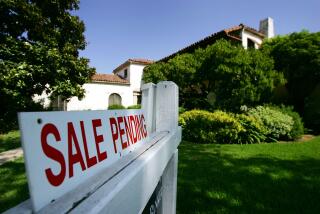How Appraisers Value a Home
His question was sincere, and typical of the confusion that reigns with homeowners--and even many real estate brokers--when it comes to my job.
I appraise houses for a major Southern California savings and loan.
“Do you use a mathematical formula?” he wanted to know.
No, I explained, there is no formula. What we do is to compare his house to others that have been sold recently in his neighborhood. This worried him because he pointed out that his house wasn’t of tract construction, so there was no exact duplicate of it.
Which is usually the case. That is why appraisal requires judgment, experience and care.
Probably the area of greatest confusion for home buyers and sellers--and surprisingly, many brokers--concerns precisely what value we are trying to determine.
Of course, everyone knows we’re looking for the “market value.” But what is that?
See Things Differently
What we’re after is an indication of what a normal buyer would pay in normal circumstances. But this gets tricky at times, or at least it would appear so to brokers and their customers when they see specific things differently than an appraiser would.
Take fireplaces, for example. A normal buyer would be inclined to pay extra for a fireplace. A fireplace adds to a home’s charm, as well as providing warmth on a cold night.
A buyer will even be likely to pay extra for a second or third fireplace. But what if (let’s go to the extreme to make a point) a house was owned by someone who loved fireplaces and built 15?
Frequently an appraiser will be told by a seller or broker what it cost to construct something; for instance, $10,000 for the 15 fireplaces. It is their expectation that the appraiser will add this to the value of the house.
“After all,” they might say, “that’s what it cost us!”
Unfortunately, that’s not the way market value works. A typical buyer won’t pay extra for the 15 fireplaces, no matter what they cost to construct. In fact, a typical buyer would probably pay less for a house with 15 fireplaces than he would for a house with only one.
What Buyer Would Pay
You see, to a typical buyer, a house with 15 fireplaces would be a freak to be avoided unless the price was right.
Perhaps 15 fireplaces isn’t a common situation, but the point is important. An appraiser is trying to determine not what something cost to construct, but only what a typical buyer would pay.
Square footage of living space is another area of confusion. It has been said that fully 75% of the value of a house is determined by its living space.
This is why an appraiser will measure a house, plotting its dimensions on grid paper. He can’t do his job properly unless he knows the square footage. Yet brokers often take listings, and determine a listing price, without measuring the house.
Sure, the broker has a listing of square footage from the county assessor’s office. But those numbers are frequently wrong, not only through mistakes but also because people add or subtract from the house without taking out permits. Thus, the tax assessor’s listing of square footage can be years out of date.
Hillsides or Flatland
Lot size needs some attention too. An appraiser will often have a proud owner say something like, “My lot is one-half acre; that’s got to be worth a lot!”
Maybe yes, maybe no.
In many areas of Southern California, the only places you will find lot sizes like that are on hillsides. Real estate is so expensive here that it just isn’t common to have one-half acre lots (about 21,000 square feet).
But keep in mind that one-half acre of flat land is worth considerably more than one-half acre on a hillside, due to what an appraiser calls utility. A hillside lot isn’t as useful as a flat lot.
On a flat lot you can build a bigger house. Or a bigger garage. Or a tennis court. Or a helicopter landing pad. But on a hillside? Generally, the extra land just looks pretty. So don’t be surprised if your large hillside lot is worth a lot less at appraisal time than you might have supposed.
A home’s neighborhood is hard to define, but it’s extremely important. There are so many variables in defining a neighborhood that it’s impossible to make a hard-and-fast list. As with so many things in appraisal, defining a neighborhood is something that requires judgment.
Selecting Comparables
It is vital, though, for an appraiser to select comparable houses (called “comps”) that are in the same neighborhood as the house being appraised.
Again, to give an extreme example, it would be totally inappropriate for an appraiser to compare a house next to a railroad track with a house at the beach.
They are in different neighborhoods, even if they’re in the same city and only a few blocks apart.
Consider a few variables and try to imagine how they would affect an appraiser’s ability to select comparable properties that would give a proper indication of the market value of your house.
Schools are a primary concern. A family will consider an area’s school system before moving into a neighborhood, thus comps should generally be in the subject’s school system.
Zoning Important
General topography is important. Hillside houses generally shouldn’t be compared with houses on flat land. Also, such things as curbs, sidewalks, street lights and street paving should be compatible. An area without these refinements may not be an adequate comparison for an area with them.
Zoning is vital and can surprise you by its results. In some areas, R-1 single family zoning may provide the most expensive residential real estate. In other areas, which have been zoned for apartments although there are still many houses in the area, multifamily zoning may provide the highest value due to the ability to put more than one unit on the site.
In one recent case, a homeowner was shocked to learn that his house was worth considerably less than his friend’s house, which was two blocks away. The friend’s house had multifamily zoning and was sold to a developer for condo construction.
In some areas, name is important. If your house is across the street from Beverly Hills, it will sell for less because it lacks something as intangible as an address.
If an appraiser for a savings and loan were to use Beverly Hills comps for such a house he would be subjecting his company to considerable possibility of loss. Many of the much-heard-about savings and loan problems have been caused by bad appraisals.
Number of Bedrooms
Another important item an appraiser looks for is the number of bedrooms. If square footage of living space is the No. 1 item, then the bedroom count is No. 2.
An appraiser looks at the real estate market as not just one overall market, but as many submarkets. In his view there is a submarket for one bedroom, another for two-bedroom houses, another for three-bedroom houses and so on.
In other words, someone who wants to buy a three-bedroom house wouldn’t generally be comparing a three-bedroom house with a two-bedroom house. Nor should an appraiser.
In most areas a house with three bedrooms will sell for more than a house with two bedrooms, even if they have the same square footage of living space.
I’d like to spend a moment on the game brokers are continually playing in trying to outsmart appraisers, and for appraisers trying to prevent it.
Brokers Need Appraisers
Appraisers need brokers because the latest sales are known first by brokers. Appraisers live by these comps. On the other hand, brokers need appraisers to get the appraisal back with an adequate value or else the deal can’t close.
So brokers are forever submitting comps that are in different neighborhoods, have an improper number of bedrooms, have views or pools that the subject property doesn’t, or for any one of a number of other specific reasons happened to sell for more than the property being appraised.
A topic often mentioned by brokers is “curb appeal.”
Curb appeal is important, but an appraiser realizes that there are so many potential opinions in the world that it isn’t easy to determine that a house has a special aesthetic appeal. What one buyer likes, another hates, so there isn’t always a definite indication of how a typical buyer would react.
For instance, some brokers will tell you that a steep and long driveway detracts from the curb appeal. While this is true for some buyers, for others it provides extra privacy and is therefore a good thing.
Pools May Not Add Value
So appeal adjustments, while possible, are something that an appraiser tries to avoid unless there is overwhelming evidence about how a typical buyer reacts. Brokers often specialize in the subjective, but appraisers must be objective.
Pools are an example of something that may not help your value. Chances are good that you can’t regain the cost of the pool in the market. Some buyers don’t want a pool because of extra trouble or expense, small children or because they can’t swim or don’t entertain.
If there is room in your yard for a pool, a buyer who wants one can build it and those who don’t want it don’t have to have it. So a pool isn’t something one builds to increase his market value. A pool should be built because you want it now.
On the other hand, if you upgrade your kitchen or bathrooms, these are modifications that are valuable in the market. Buyers want to see upgraded kitchens and bathrooms in even the oldest houses.
After an appraiser has done all the field work--inspected the subject, looked through the neighborhood and found appropriate comps--he goes back to the office and spends an hour on the computer.
Adding and Subtracting
What happens is this: Comps are listed with their sales prices at the top of a grid. As the appraiser works his way down the grid, he makes “adjustments” for comp items that are different than the subject.
In other words, he is adding to or subtracting from the actual sales price of the comps to try to make them like the subject. If the comp has a pool and the subject doesn’t, then the appraiser will subtract some of the comp’s sales price, in effect trying to remove the pool from the comp to make it like the subject.
Again, all the adjustments are derived (through the experience of the appraiser and/or his company) from the market. They are an attempt at reproducing what the typical buyer would pay for the various items that make up a home.
At the end of the grid, the adjustments are combined with the actual sales price of the comp to form an “adjusted sales price.” In theory then, this is what the subject would have sold for based on the comp’s sale.
Three comps are generally treated in this way on the appraisal form, so there are three adjusted sales prices at the bottom (the three never seem to match precisely). The appraiser then considers these three to form the range of probable market value for the subject property.
He decides what dollar amount in the range would be the most probable market value, and that becomes his bottom-line figure--his estimate of market value.
READER IDEAS FOR SPEAKING OUT
Readers wishing to express their views on topics of interest should send queries or manuscripts to Real Estate Editor, Los Angeles Times, Times Mirror Square, Los Angeles, 90053.
More to Read
Inside the business of entertainment
The Wide Shot brings you news, analysis and insights on everything from streaming wars to production — and what it all means for the future.
You may occasionally receive promotional content from the Los Angeles Times.










